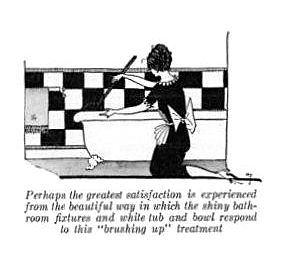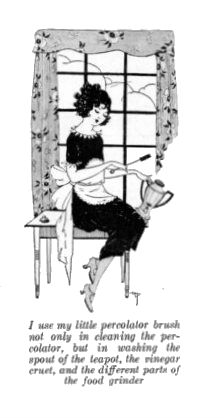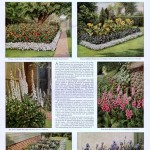Recently I purchased a couple of tiny, old magazines simply because they looked interesting and I had never heard of that title before. They were called “Beauty and Health,” and both were published in 1905. However, when I looked closer at one of the covers, I noticed the print on the very bottom which stated: “Physical Culture Publishing Co., Physical Culture City, Spotswood P.O., N.J.” Immediately the magazines grew much more fascinating to me, because I actually live very close to the town of Spotswood and had never heard of this Physical Culture city!

Location of Spotswood, NJ, where Physical Culture City was founded in 1905. Image courtesy Wikimedia Commons
Physical Culture City
A matter of a little time searching the internet and I soon found out that there was indeed an actual “Physical Culture City” in my area, founded in the year 1905 and in existence for only a short time. It seems that this group of people got together, under the founder Bernarr Macfadden, in order to live a natural, healthy life featuring a vegetarian diet and a lot of exercise, no drugs, and no tobacco. My local paper contained a short article about the group here where you can see a photo of the healthy-looking group with some of the members standing on each other’s shoulders!
The “Beauty and Health” magazines that I have were printed here in this city in Spotswood. There is a great picture of the publishing company building here, along with many other wonderful pictures on the Bernarr Macfacden website. In the end, Physical Culture City only lasted about three years and ended amidst various lawsuits as well as complaints that the residents dressed indecently outside the community (apparently this referred to the bathing suits and bloomers they sometimes wore). It’s a very interesting story and one that I highly recommend reading more about if you are so inclined.
The Four Exercises Using Bedroom Furniture
However, in this entry I’ll be focusing on one particular article in the October, 1905 issue of Beauty and Health magazine. The article is called “Exercises for Building Internal Vital Power”, and is the “Eleventh of a Series of Valuable Articles by the Editor on How to Exercise With no Other Apparatus than Ordinary Bedroom Furniture.” That’s right, this article was penned by none other than Physical Culture City’s founder, Bernarr Macfadden. To me, the best part of the article are the wonderful photos of an Edwardian woman in a leotard (perhaps some of the “indecent attire” the community complained about!) doing the various exercises on her bed.
Macfadden starts out by stating that:
“…I am offering a few movements which I consider of great value, and are designed to build a vigorous condition of the internal functional system. Although beauty and strength of the exterior parts of the body is very desirable, and necessary, yet strength of the heart, lungs, and the entire digestive and functional system is after all of much more importance. Once may lose a leg or an arm, and still live, but one is absolutely dependent upon the important vital organs for every moment of life.”
Here now are the four exercises focused on in this article. They could be a good choice for exercise on a snow day when you’re stuck in the house anyway, or even to try out of mere curiosity to see how they work.
EXERCISE No. 1 – Lie on your back across the bed, placing hands far back of the head and taking hold of the other edge of the bedstead with them. Now bring both feet together up and as far back as possible, as shown in the ilustration. The farther you carry this movement, the better, though be careful not to fall off the bed. Bring feet down and repeat the movement, continuing until tired.
EXERCISE No. 2 - Lie face downward across the bed, the feet being held securely down by hooking them under a towel tied to the edge of the bed, as shown in photo. Place hands on hips, with head hanging far down over the edge of the bed, then raise head and shoulders as high as you can, to the position illustrated. Endeavor to raise still higher, and then repeat the entire movement, continuing until tired.
EXERCISE No. 3 – Recline on the right side, bracing yourself by taking hold of the rods at the head of the bed, as illustrated above. Now with weight of the body entirely on feet and shoulder, raise the hips up sideways as high as possible, and repeat the movement until tired. Same movement on the left side. Another splendid exercise can be taken from the same position by keeping feet together, and knees straight, raising the feet up sideways as high as possible, repeating until tired. Same on other side.
EXERCISE No. 4 - Assume position shown in photo, with back towards the bed, hands on edge, as illustrated, and feet about four feet away. Keeping the elbows and knees straight, first lower the hips as much as is convenient, then raise them to the position illustrated, or considerably higher, if possible. Repeat the movement until tired.
In closing, here are some more words from Macfadden from the article, concerning his view of what physical culture really means:
“True physical culture means not alone the development of the muscular system, but it also means the possession of pure blood, together with superior bodily health, all of which means the true happiness that comes of the possession of physical perfection allied to sound mentality. You will not only find life more satisfactory and enjoyable, through the medium of these exercises, but by improving the condition of the vital organs by which life is sustained, you will be able to live to a much greater age than otherwise.”




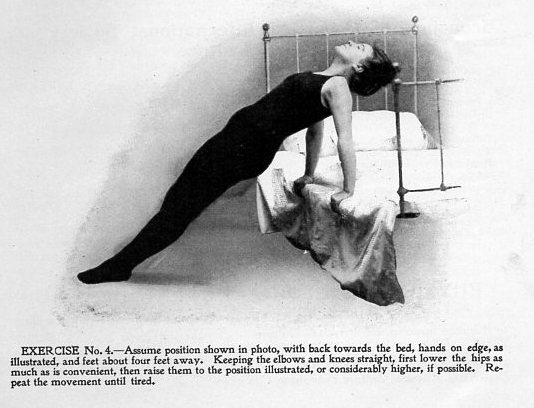



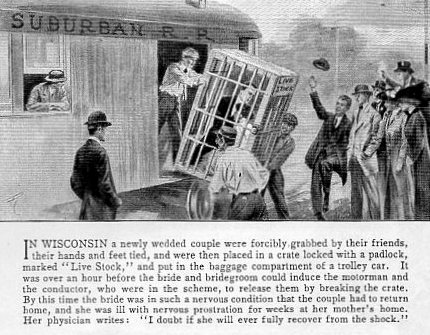

 Vintage Travel 1920′s French Riviera Wedding Card
Vintage Travel 1920′s French Riviera Wedding Card Save The Date Postage Stamp
Save The Date Postage Stamp Vintage Pink Orchids on Modern Pink Stripes Cards
Vintage Pink Orchids on Modern Pink Stripes Cards Vintage Edwardian Bride and Groom Postage Stamp
Vintage Edwardian Bride and Groom Postage Stamp Ebony Vintage Gramophone Save the Date Postcard
Ebony Vintage Gramophone Save the Date Postcard 1900s Vintage Edwardian Wedding Shower Invitation
1900s Vintage Edwardian Wedding Shower Invitation

